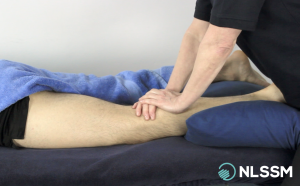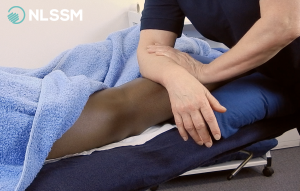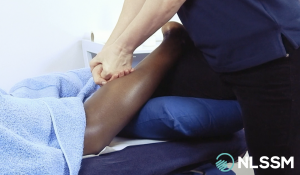Effleurage is a technique known as an introductory stroke which is applied in the early stages of massage. It helps the therapist to familiarise themselves with the client but equally so the client can start to settle into the treatment. Effleurage has many other purposes, it is used to warm up the tissue, it’s used as a palpatory tool, but more often than not it can connect one technique to another or one area of the body to another. I often refer to it as my ‘thinking technique’, while I am trying to decide what other stroke to use I often revert back to effleurage during this decision making process.
Effleurage originates from the French word, effleurer, which means ‘to skim’ (1). This is a useful reflection; it epitomises all the movements associated with effleurage. Strokes are gentle and utilise light or gentle pressure (2). Lisa Casanelia, author of Foundations of Massage, suggests that the pressure can be likened to the caress of a loved one or the petting of a favourite animal (3).
It can be applied superficially, which tends to have a reflexive value, and deeply, which has a more mechanical value. It is an incredibly popular technique; used over centuries; across numerous cultures; adopted in nursing as a traditional, nonpharmacological means of promoting rest and relaxation (4). It is a useful pathway for the rest of the massage, and there are many different ways to implement it.
Whenever you are performing effleurage, the hands should be relaxed. If you find yourself stiffening up, shake the hands out. This will create a much more floppy, softened feeling – exactly what is needed for effleurage. You will find I refer to what is a mindful touch in many articles and videos, I often demonstrate how to apply a stroke that is both non-invasive but can also be deep. The most important part of this equation is the contact hand must remain relaxed, the power mostly comes from how you use your body, we refer to this as your biomechanics.
The conventional direction of this technique is longitudinal, with deeper application towards the heart followed by a lighter returning stroke. This approach is up for discussion as it was once believed that we should not be working contrary to the direction of venous return. However, in a healthy person this does not appear to be true, a therapist can apply their strokes in any direction. There are some circumstances that require us to move towards that heart i.e. circulatory problems like congestive heart failure especially if they are showing signs of oedema, but there isn’t any research demonstrating the need to move towards the heart in a healthy per
The following list are common methods of application, these are not named by me, I only talk about them to demonstrate a variety of strokes that are all considered effleurage. Personally, I love effleurage because of the range of creative choices this technique has to offer, by changing direction, speed, application tools, utilizing different combinations, makes your choices infinite.
Rowing Stroke
This is one of the first techniques used within effleurage. It is a stroke that integrates a number of other strokes, transitioning from one to another as the therapist moves around the table. In this stroke, hands are broad and flat, with the entire surface area of the hand making contact with the tissue. As with most techniques under effleurage, fingers should be relaxed and gentle; not rigid and firm (5).

Half-Rowing Stroke
The half-rowing stroke is also known as reinforced effleurage. It is a technique that allows the therapist to penetrate deeper tissues, following the soft introductory movements of the rowing stroke. Unlike the rowing stroke, two hands merge to become one. The therapist then focuses all their bodyweight through this one hand. This greater pressure allows the therapist to go deeper with their movements. Remember though, these are all effleurage so should be soothing and gentle (6).
 Forearm Effleurage
Forearm Effleurage
This is performed with the fleshy part of the therapist’s shoulder. It can be used swiftly to warm the superficial layers of tissue, or slowly and directly to penetrate deeper tissues. It is important therapists do not clench their fist, during this process. A tense and clenched fist means the forearm contracts, and the technique becomes far more forceful and rigid (7).
 Fist Effleurage
Fist Effleurage
Fist effleurage is applied with the flat side of a loosely clenched fist. The therapist’s other hand is wrapped around the forehand to reinforce this downward motion. It is a technique used to target larger muscle groups which are either well-developed or incredibly tight (8).
Hand after Hand
These are short alternating strokes that should try and replicate the feeling of one continuous stroke. Designed to sooth and warm tissues, it is a rhythmic technique where the hands follow one another and alternate (9).
Side Pulls and Nerve Strokes
Side pulls are fairly unusual in comparison to most other effleurage techniques because of the direction of movement. Instead of stroking forward, the therapist is required to place both hands on the far side of the client and pull back toward them. Nerve strokes – also known as cat strokes or feather strokes – are incredibly delicate. They are a light stroking motion, performed slowly with hardly any pressure; using the fingertips. This stroke is usually applied as an ending technique, because it is the lightest and softest of all effleurage practices (10).
The Benefits of Effleurage Techniques
A Good First Impression
As mentioned, this is an introductory technique, so it is important to get it right. Essentially the opening chapter for your client’s massage story, it sets the tone for other techniques you intend to introduce. Therefore, it is perfect for warming up the body, and making the client feel comfortable.
Early Understanding
The slow and long strokes of effleurage techniques are a great insight into how the client’s body works, and where they may be experiencing tension. The pace allows therapists to access a real sense of the body’s condition, and how the client reacts to certain movements. Vitally, our understanding can inform us of how we are going to do the rest of massage session.
Relax
The steady and rhythmic movements also relax the client. Sometimes clients may arrive feeling stressed, fatigued or uncomfortable. Effleurage techniques are the perfect way to suppress these feelings and calm the client. The movements promote complete relaxation; increase body temperature; lower heart rate and release ‘feel good’ hormones (11). If relaxation is the intention of your session, then speed and feeling what is under your hands is of the utmost importance. Pushing through a stroke without considering the reaction of the connective tissue diminishes the effectiveness of your touch. I am of the same mindset no matter what this client is coming in for, a mindful touch will assist you in evaluating and treating the connective tissue more effectively, listening with your hands should be number one in every therapists tool box.
Circulation
Old school thinking believed that we increased circulation, despite the lack of evidence of this being the case, it is a belief that is being held on to by many educational programs. However, we are making changes to the soft tissues environment, we can soften adhesions and relax areas of tension, increase the functionality of tissue, work with the nervous system, improve movement, a variety of positive outcomes, but it has not been demonstrated that we increase blood flow rate. This particular technique is associated with slower and minimalistic movements; its effects can be seen throughout the body and improve general wellbeing. Minor pressure with greater outcomes (12).
Boosts Mood – Improves Mental Wellbeing
As briefly mentioned, the effleurage technique releases the ‘feel good’ hormones – endorphins. These are pain-relievers and serotonin boosters which, when released, a vastly improves a person’s social wellbeing. These positive psychological outcomes are why many people utilise massage as a solution for mental health. Effleurage is just the start of this.
Effleurage is an invaluable introductory technique. To those outside massage therapy, some of the movements and types of pressure applied may seem almost non-existent and needless. It may appear this way, but effleurage is a relaxing technique, with a number of physiological and psychological benefits. It is also an assessment tool, used for both superficial and deep evaluation of the tissue. It is the best way to start most massage sessions. It allows both client and therapist to get fully comfortable and instils a calming atmosphere. Effleurage is a favourite, it’s a technique that is foundational to every therapist’s massage session.
References
- Martin Petkov. Blog. 2017. Massage techniques: effleurage and petrissage, [online], available at: https://www.martinpetkov.com/your-opportunity/massage-techniques-effleurage-and-petrissage [accessed 24 June 2020].
- Brummitt, J. 2008. The Role of Massage in Sports Performance and Rehabilitation: Current Evidence and Future Direction, [online], available at: https://www.ncbi.nlm.nih.gov/pmc/articles/PMC2953308/ [accessed 24 June 2020].
- Casanelia, L., Stelfox, D. 2009. Foundations of Massage, Elsevier Australia, [online], available at: https://books.google.co.uk/books?hl=en&lr=&id=JZWolU9MG6sC&oi=fnd&pg=PA163&dq=effleurage+techniques+&ots=IQcIBZiK-K&sig=cPTrv8OIkafhSsGCnkwvyMmcE3E#v=onepage&q=effleurage%20techniques&f=false [accessed 24 June 2020].
- Labayak, S. and Metzger, B. 1997. The Effects of Effleurage Backrub on the Physiological Components of Relaxation: A Meta-Analysis in Nursing Research, 46(1), [online], available at: http://ovidsp.ovid.com/ovidweb.cgi?T=JS&PAGE=reference&D=ovftc&NEWS=N&AN=00006199-199701000-00010. [accessed 24 June 2020].
- Casanelia, L., Stelfox, D. 2009. Foundations of Massage.
- ibid.
- ibid.
- ibid
- Casanelia, L., Stelfox, D. 2009. Foundations of Massage.
- ibid
- Martin Petkov. Blog. 2017. Massage techniques: effleurage and petrissage.
- ibid

